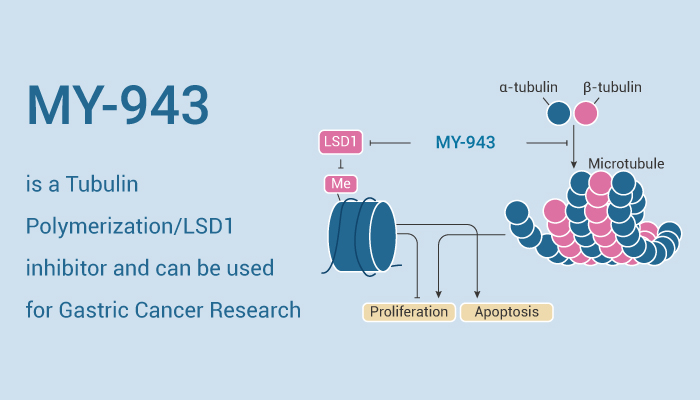MY-943 is a potent tubulin polymerization and LSD1 inhibitor with anticancer activity. Tubulin in molecular biology can refer either to the tubulin protein superfamily of globular proteins, or one of the member proteins of that superfamily. In eukaryotes, there are six members of the tubulin superfamily, although not all are present in all species. Both α and β tubulins have a mass of around 50 kDa and are thus in a similar range compared to actin (with a mass of ~42 kDa). In contrast, microtubules tend to be much bigger than actin filaments due to their cylindrical nature. α- and β-tubulins polymerize into microtubules, a major component of the eukaryotic cytoskeleton. Microtubules function in many essential cellular processes, including mitosis. Tubulin-binding drugs kill cancerous cells by inhibiting microtubule dynamics, which are required for DNA segregation and therefore cell division.
Lysine-specific demethylase 1 (LSD1) is the protein that exhibits histone demethylase activity. LSD1 targets mono- or di-methylated histone H3K4 and H3K9 as well as non-histone substrates and functions in the regulation of gene expression as a transcriptional repressor or activator. This enzyme plays a pivotal role in various physiological processes, including development, differentiation, inflammation, thermogenesis, neuronal and cerebral physiology, and the maintenance of stemness in stem cells. LSD1 also participates in pathological processes, including cancer as the most representative disease. It promotes oncogenesis by facilitating the survival of cancer cells and by generating a pro-cancer microenvironment.
MY-943 is a dual inhibitor of tubulin polymerization and LSD1 that inhibit gastric cancer.
MY-943 inhibits tubulin polymerization and suppressed LSD1 at the enzymatic levels. Specifically, MY-943 could act on the colchicine binding site of β-tubulin, thus disrupting the construction of cell microtubule network and affecting the mitosis. Therefore, MY-943 displays significant antiproliferative activities with IC50 values at the nanomolar level. In addition, MY-943 could dose-dependently induce the accumulation of H3K4me1/2 and H3K9me2. MY-943 could induce G2/M phase arrest and cell apoptosis, and suppress migration in MGC-803 and SGC-7901 cells. In addition, MY-943 significantly modulates the expression of apoptosis- and cycle-related proteins. Furthermore, MY-943 effectively reduces the weight and volume of gastric cancer in vivo without obvious toxicity.
All in all, MY-943 is an effective dual inhibitor of tubulin polymerization and LSD1 that inhibits gastric cancers.
References:
[1] Bera A, et, al. Front Cell Dev Biol. 2022 Jul 5;10:913809.
[2] Kim D, et, al. J Biomed Sci. 2021 Jun 4;28(1):41.
[3] Yuan XY, et, al. Eur J Med Chem. 2023 Apr 5;252:115281.
